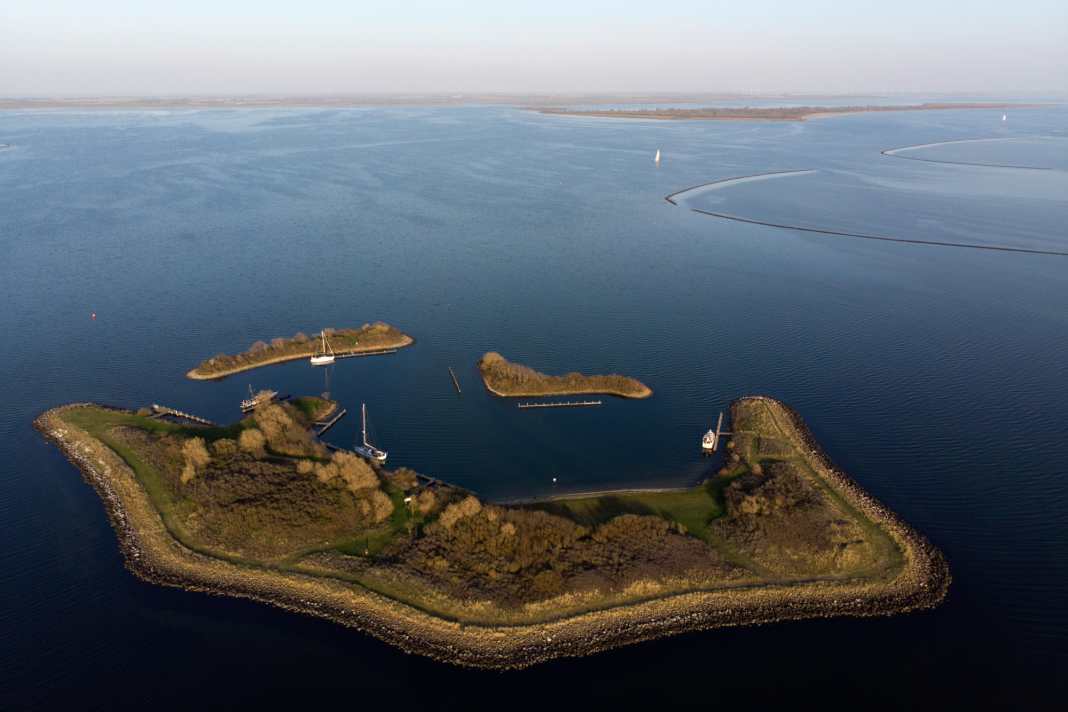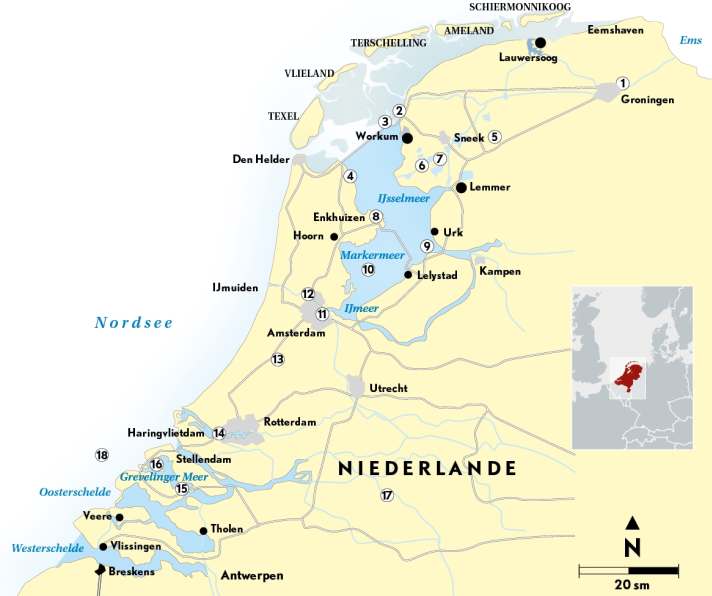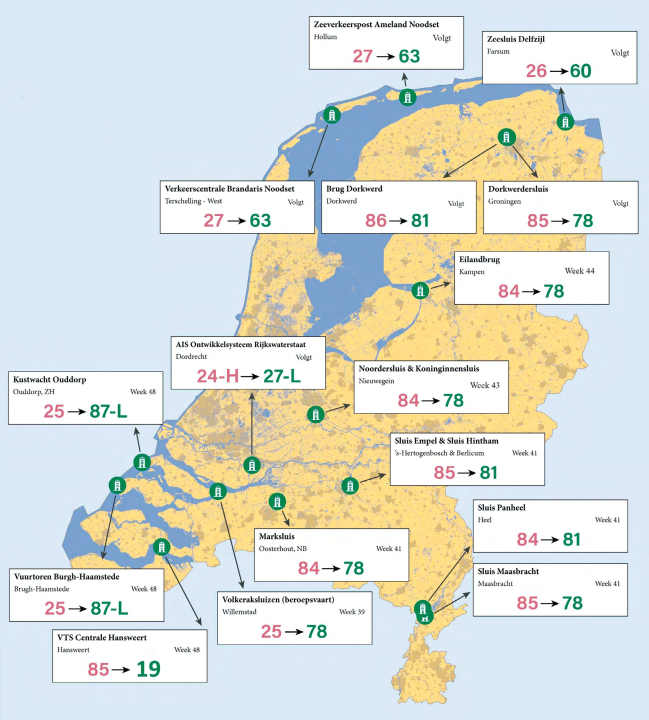Revierreport: What's going on in Holland? The big update at the start of the season
Alexander Worms
· 05.05.2023






Unfortunately, it only became apparent last year, after our annual report for the Netherlands had gone to press, that the closure of the Driebondsbrug between Delfzijl and Groningen was really dragging on. Normally this wouldn't be a big deal, as there are a large number of waterways in the neighbouring country and there is always an alternative route. However, the problem here is more serious: the Driebondsbrug is located on the Staande Mastroute, one of the most important inland waterways for sailing yacht crews who want to travel from one area to the next with a rig.
Allegedly, the bridge's control technology is irreparable. Manual operation is possible, but expensive. For this reason, the bridge is currently only opened manually for special transports for commercial shipping. Yachts can at least then slip through (point 1).
And things are literally not working elsewhere in the neighbouring country either: both the Coenbrug in Zaandam and the Haringvliet Bridge remain closed. In the case of Zaandam, the possible alternative route is also impassable: the Krommenie Bridge there has also been hit. In view of the almost countless water and bridge structures in the Netherlands, a few individual failures seem acceptable. However, key points are often affected. Just as the number of short-term bridge and lock failures seems to have increased recently.
The responsible authority, Rijkswaterstaat, knows that the infrastructure urgently needs to be modernised. And they are reacting and investing, but it takes time. In the case of the Haringvliet Bridge, it is a whole year without service during the construction phase.
A lot of money is also flowing into other projects: The Meuse locks are being renovated one by one. The Kornwerderzand lock is being expanded. The bridges over the Prinses Magrietkanaal are being renewed.
A completely different permanent construction site in the figurative sense is the wrangling over the planned sealing of the seacocks of toilet outlets. So far, there is neither a functioning faeces pumping infrastructure nor usable and affordable wastewater treatment systems on board yachts. The project has therefore been postponed until 2026.
Instead, another topic is currently causing a stir: the large signs in the locks "Schip vast, Schroef uit" are familiar to many water sports enthusiasts in the Netherlands. They mean: If the ship is stuck, the propeller must be put into neutral. Steaming permanently into the fore spring, which is popular with commercial vessels with a small crew, is prohibited. However, a judge has now cancelled a fine imposed on a professional ship captain who did exactly that. In this case, turning the propeller was nautically correct. The discussion as to whether this always applies in all locks was not long in coming. Rijkswaterstaat clarifies: No! The professional skippers, however, are not prepared to accept this. Recreational skippers should therefore be on their guard in future. Better to wait for a lock passage than to be pushed against the wall by the screw water of a freighter.
The following overview shows what else is happening in the country's sailing areas.

1st Driebondsbrug
As mentioned at the beginning, the bridge off Groningen is closed until further notice. It will only be opened occasionally for commercial vessels. Yachts are then also allowed through. Rijkswaterstaat will inform you a few days in advance when the next opening is planned, including by newsletter. You can subscribe to this by sending an e-mail to nautischloketNN@rws.nl.
2. depth Boontjes
The fairway between Kornwerderzand and Harlingen is silting up. It is still kept at 3.80 metres below NAP. However, as dredging has been criticised for its negative impact on the environment, a depth of only 2.80 metres below NAP could be guaranteed in future. At LAT, there would then only be around 1.60 metres of water above the bar at Harlingen.
3rd Kornwerderzand lock
The large chamber will be widened by 2028 so that larger ships can then be channelled through.
4. solar islands off Medemblik
Artificial islands are to be created between the bird island of Kreupel and Den Oever, on which solar panels will be installed. In between, fairways and moorings are planned. According to the initiators, the islands are good for water quality, water sports, fish and birds. The proposal is currently at the Ministry of the Environment for comment, the outcome is uncertain.
5. bridges in Friesland
The Oude Schouw, Uitwellingerga and Spannenburg bridges will now be renewed after all. The Hague has finally made the necessary funds available. Preparations are already underway and the first construction measures have been announced for this year. The first bridges should be ready by 2025.
6th fish snack bar in Heeg open again
The closure of the "Oude Vishal" - almost an institution with cult status in Heeg - had caused quite a stir among water sports enthusiasts. As a result, the old owners are now carrying on and reopening their fish stall from 11.30 a.m. to 8 p.m. on Fridays to Sundays.
7. winter sailing in Friesland
Charter companies, the province and even bakers from the region have joined forces to make the waters more accessible for boaters in winter. The administration is converting more and more bridges to year-round operation via app. Charter companies that take part in the campaign also undertake to provide boats from other companies with electricity and water at their jetties. And the bakers deliver fresh bread rolls on board.
8th Bungalowpark Enkhuizen
A new bungalow development is being built to the north of the town. The beach there is also being redesigned as part of the construction work. It is to become more attractive in general and will be equipped with play equipment. Ideal for families. The beach is within walking distance of the Compagnieshaven. Construction is due to start this year.
9. wind energy off Urk
The wind farm between the Ketelbrug and Lelystad is being modernised and driving on it is currently prohibited. The restricted area is tightly buoyed. Water sports enthusiasts travelling from Urk or the Ketelmeer to Lelystad have to sail around it in an arc.
10. water plant warning device
The problem of weeds in the Markermeer and the marginal marshes remains. Only about one per cent of the area is mowed where necessary. A new app should now show even better which areas sailors should avoid. The data is based on aerial photographs and simulations and can be accessed via app and internet browser.
11 Amsterdam
If you want to drive through Amsterdam on the Staande Mastroute, you need a vignette. It costs 40 euros and is valid for three years. It can be ordered online and is sent by post. This takes about ten days to Germany. If you want to drive through Amsterdam spontaneously, you can specify when ordering that the vignette should be collected locally. The locations where this is possible will be indicated at the time of purchase.
12th Staande Mastroute
In Noord-Holland, the inland waterway is currently not continuously navigable with a standing mast. The Coenbrug in Zaandam remains closed for the time being, the clearance height is 6.20 metres. There is no alternative via the Nauernasche Vaart on the western route, as the Krommenie bridge is also defective. Whether and when it can be repaired is unclear.
13th Narrow of Boskoop
South of Alphen aan den Rijn, the Staande Mastroute runs through Boskoop. The very narrow fairway there is being widened. Due to the work, recreational craft will only be able to pass through from 9.15 to 9.45 and from 14.45 to 15.15 every day from 11 April to 30 June. The times are coordinated with the subsequent bridge openings on the Staande Mastroute.
14th Haringvlietbrug
The Haringvlietbrug will be renovated until the end of 2023. The flap of the movable bridge section will be replaced and cannot be opened during the construction period. The clearance height is 13 metres.
15th Grevelingen Sea
Openings had only just been made in the dykes to the North Sea and Oosterschelde to promote the exchange of water. The water quality in the Grevelingen Sea had become too poor. Now they are considering turning the water into a huge freshwater basin. The reason: farmers are increasingly struggling with the salinisation of their fields due to the increasingly dry summers. If there is no counter-pressure from fresh water within, salt water from the North Sea gradually migrates under the dykes and onto the fields. The new plans aim to counteract this and at the same time gain an enormous water reservoir in the south of the Netherlands.
16th Grevelingen Sea Card
If you want to visit the islands in the Grevelingen Sea, you have to pay a fee. This will be increased by 56 per cent for the 2023 season. The weekly ticket will then cost just under 20 euros.
17th Meuse locks
The locks are being modernised. The associated work on the Linne, Roermond, Belfeld and Sambeek locks began in April. This may result in longer waiting times for water sports enthusiasts.
18. wind farm Borssele
Wind farms on the North Sea should actually be freely navigable, at least during the day and for ships with VHF radio and AIS. At the Borssele wind farm, however, there is only a narrow corridor that ships are allowed to use. The Watersportverbond has filed a lawsuit against this. They fear that other parks will follow suit and restrict the generally free passage to small areas.
New radio channels in the Netherlands

Due to international changes in the use of radio frequencies, the call channels of various buildings have changed (red: old, green: new VHF channels). The new channels are also posted on the structures and in the block channel areas.

